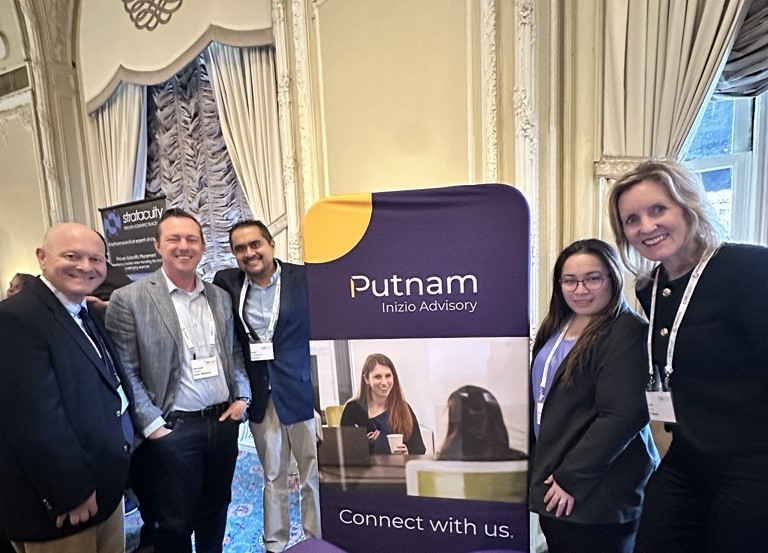Highlights from the CMO Summit 2024 (Boston, MA)
The 12th annual CMO Summit took place in Boston, MA, from April 17-18, convening Chief Medical Officers (CMOs) and Medical leaders across pharma, biotech, and medical devices. The event was an invaluable networking opportunity for CMOs and Medical therapeutic area (TA) leaders to connect and candidly share advice and best practices, with both first-time and veteran CMOs in attendance. As always, the event addressed key themes these leaders are navigating today across firms of different sizes and stages, with an emphasis on earlier stage, pre-commercial companies. These themes included clinical trial optimization, navigating funding and business development, leading their organizations through volatility (especially in the current macroeconomic environment), and preparing assets and organizations for successful late-stage development and launch.
Clinical trial optimization and patient-centric trial design
CMOs and Medical leaders – especially those in smaller, pre-commercial organizations – are deeply involved in asset Clinical Development (and often, Clinical Operations). As one of (if not the largest) driver of operating cost in these companies, clinical trial design – and optimizing protocols, patient- and site selection – was a major focus of several sessions and panels at the summit. Major themes explored included:
- Thoughtful selection of assays and variables (e.g., use of continuous measures like lab values and streamlining patient-reported outcomes (PROs) to minimize burden to patients, number of endpoints, measurement time, and cost; use of focused endpoints like specific lab values or clinical signs rather than collecting standard lab panels or full physical examinations at each visit);
- Site selection leveraging AI-enabled claims analytics to pre-identify centers treating populations of interest – balancing recruitment across a mix of patient demographics and regions, academic/ community medical centers, and established KOLs and ‘up-and-coming’ junior trialists – to ensure consistent patient recruitment (especially amidst competing trials of drugs with similar mechanisms of action) and achieve broader health equity in clinical trials;
- ‘Prognostic enrichment’ of enrolled patient populations (e.g., through early use of established biomarkers, or novel, machine learning (ML)-identified clinical and biomarker signatures) with higher probability of treatment response or reduced probability of adverse events;
- Thoughtful patient engagement in clinical trial design to maximize adherence to protocol (e.g., reducing numbers and complexity of visits/ assays, home collection where possible);
- Focus on product orientation that will matter to key stakeholders rather than just achieving a proof of concept (e.g., ensuring the trial is designed to demonstrate a meaningful impact patients, physicians, and payers find important);
- Regular interim analyses for treatment efficacy/ safety (including ML biomarker analyses of super- and non-responders) to further enrich ongoing enrolled populations, or stop for futility (if necessary)
Indeed, many panelists reported incorporation of the above themes in their trial protocol design had – or could have – minimized the need for cost-, labor- and time-intensive trial amendments, improved patient recruitment, or pre-identified unfavorable therapeutic indices earlier.
Navigating funding and business development
Access to capital – whether through institutional investors or via pharma partnership/ acquisition – was a hiot topic at the CMO Summit this year. Panels were hosted by traditional financial services firms, venture capital/ private equity, and venture arms of large pharma. Across investor types, common themes emerged as priorities for investors appraising pre-commercial companies: clear line of sight to clinical data (i.e., well-defined clinical development plan into human proof-of-concept studies), established assays/ endpoints, and validated drug targets. A notable exception to these priorities, as mentioned by several large pharma and venture capitalist investors, was the ability to invest earlier (at a discount, or ‘low ticket size’) in novel mechanisms of action at the pre-clinical stage.
CMO leadership amidst volatility
Sessions also provided guidance on key internally and externally facing leadership skills for CMOs, especially in recent years during substantial macroeconomic volatility. Major topics included:
- Internal management and communication, especially during periods of organizational restructuring, and the cruciality of maintaining regular and open lines of communication with employees around major events like trial failures or corporate acquisitions;
- Ways of working within their broader leadership teams, and balancing the need for both scientific/ Medical rigor (as the ‘voice of the patient’) and a consistent leadership narrative (remaining in lockstep with CEO) in front of Boards of Directors (BoD)1 and investors;
- Interacting with collaborating medical centers and trialists, including clear delineation of expectations around patient recruitment and protocol execution, establishing a regular review cadence with sites and investigators on trial progress, and managing impromptu issues that may arise
A consistent theme among attendees and panelists/ presenters, especially in earlier-stage organizations, was the unique role CMOs often play as the single (or one of a small number of) Medical/ Clinical experts in their organizations. In addition to stewarding day-to-day clinical trial execution and overall Medical/ Clinical leadership, the additional responsibility of executive leadership – and the need to translate scientific and clinical nuance across audiences – makes the CMO job as demanding as it is exhilarating.
Preparing assets and organizations for late-stage development and launch
An asset’s journey from clinical development to launch readiness has become increasingly complex and challenging to navigate. The journey often involves extensive planning and strategic execution across an organization’s multiple functional areas to maximize the value of launch and promote commercial success. Recognizing the pivotal role that CMOs play in the launch process, Day 1 of the CMO Summit concluded with an industry expert-led panel on the actions that CMOs should consider as they prepare assets for launch. Among launch readiness actions suggested include:
- Create a cohesive scientific narrative that articulates the disease burden, unmet need, and the asset’s scientific rationale;
- Develop a compelling, fit-for-purpose value story that communicates the positioning and value of a new therapy in the target population and support decision-making;
- Establish an integrated evidence plan early that will enable cross-functional engagement to identify evidence gaps and create a roadmap of potential solutions that can be executed and tracked over time;
- Map the patient journey to gain an in-depth understanding of the patient experience and define key pain points in the process, including where a new therapy might fit;
- Develop a stakeholder engagement plan early in development that considers the unique needs of key opinion leaders, providers, and patients rather than only relying on insights from trialists. Leverage medical insights early and often to optimize the clinical development plan, TPP, situational analysis, ISTs, and life cycle management plan;
- Ensure you have meaningful impact metrics aligned to your launch strategic imperatives to demonstrate early success in the first six months and at one year (e.g., metrics that show a change in perception, narrative, behavior, or guidelines)
Learn how we’re helping clients transform with impact.
Sources:
- Several panelists mentioned the benefit of convening a smaller “Science Committee” subset of the BoD prior to formal Board meetings to explicitly discuss scientific/ clinical development planning and address nuanced questions

Jump to a slide with the slide dots.
 Lori Klein, PharmD
Lori Klein, PharmD
How Medical Affairs is Embracing AI to Drive Precision and Impact
Explore how AI is reshaping Medical Affairs, driving precision, enhancing patient outcomes, and unlocking new opportunities for biopharma in 2025
Read more Rudiger Papsch
Rudiger Papsch
MAPS EMEA 2025: Driving Transformation and Excellence in Medical Affairs
Explore how MAPS EMEA 2025 redefined Medical Affairs - patient-centricity, AI, evidence generation & launch excellence take center stage
Read more Jo Ann Saitta
Jo Ann Saitta
Why AI Needs Humans: The Critical Thinking Advantage in Pharmaceutical Commercialization
AI speeds pharma insights, but human experts turn them into action. ClarityNav blends AI power with strategic, real-world expertise.
Read more
